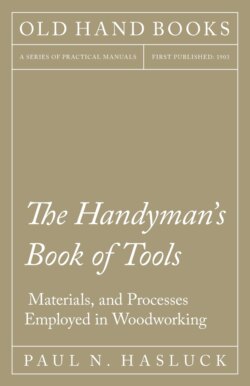Читать книгу The Handyman's Book of Tools, Materials, and Processes Employed in Woodworking - Paul N. Hasluck - Страница 87
На сайте Литреса книга снята с продажи.
VARIETIES OF HAND SAWS AND THEIR USES.
ОглавлениеThe ordinary wood-worker has some six or eight saws, comprising the rip, cross-cut, hand, panel, tenon, dovetail, bow or turning, and keyhole. The hand saw type includes the hand saw proper, the ripping, half-ripping, and panel saws, all of similar outline, but differing in dimensions, and in form and size of teeth. There is no sharp distinction between these tools, as they merge one into the other; yet at the extremes it would be impossible to substitute the ripping and panel saws one for the other. The hand saw, however, which is a kind of compromise between extremes, is used in discriminately for all purposes. Representative hand saws are illustrated by Figs. 238 to 243. Fig. 238 shows a saw with straight back; Fig. 239 shows a saw with nibbed back; Fig. 240 is a skew back or round back saw which runs without any “set”; it is of extremely high temper. Fig. 241 shows a hand saw with its back edge graduated as a rule. Fig. 242 is a perforated saw with American shaped teeth, and Fig. 243 is a “one-man” two-handled saw, the extra handle being removable at will. The typical hand saw is from 24 in. to 28 in. long, being measured on the blade, which corresponds with the maximum range of thrust of which the arm is capable. Its blade is as thin as possible consistent with sufficient strength to prevent the saw buckling under thrust. The blade tapers in length, a form which is also best calculated to withstand thrusting stress without unduly increasing the mass of metal. The handle completely encloses the hand, so that muscular effort is not required to keep the hand from slipping away from its proper grasp. The teeth are bent to right and left alternately, while their outline is angular—the cutting angle being so obtuse that it is apparently ill-fitted for dividing fibres. Lastly, the teeth are so sharpened that their outer points first enter the wood, and the fibre is divided by a gradually incisive kind of action. Not one of these points can be neglected with impunity, for they all conduce to the proper operation of the hand saw. Six teeth to the inch are very suitable for a hand saw. This tool is used for the coarser kinds of work, sawing off stuff—especially large stuff—and for use on buildings, trimming joists, and cutting rafters, halving plates together, and other rough jobs; it is not much required in a shop. As a good general tool in a shop, or for fixing work in the interior of a house, a panel saw is much to be preferred. This is a saw about 2 in. or 3 in. shorter, and much narrower, thinner, and lighter than the hand saw. If a panel saw is once taken to for general work, the hand saw will not be much used, except for heavy work. For cutting along the grain (technically known as ripping) is used the rip saw, as by means of its large teeth the work may be accomplished more quickly than with the band saw. The blade is about 28 in. long, and there are three teeth to the inch, these being sharpened square across the blade, and set very much forward. For cutting shoulders, the tenon saw is used, owing to the teeth being finer, thus producing the clean cut which is so desirable for this purpose. Figs. 244 to 246 show three tenon saws, which differ only very slightly from one another. The common tenon saw has more or less both of set and rake, according to the material upon which it is chiefly used. Usually it is set and sharpened in a medium or average style for general bench use. But according to the character of the work mainly done, the size of the saw selected is from the 12-in. or 14-in. tenon to the 6-in. or 8-in. dovetail, the teeth in the latter case being so fine that the thinnest wood and the most delicate joints can be cut without risk of tearing up the grain. As to the proper saws to be used for cutting the parts of joinery, there can be no hard-and-fast rules laid down. A tenon may be so large that it may be formed by cutting with the grain with the rip saw. and across the grain with a panel saw, or so small that a dovetail saw is of ample size for both purposes. Again, a dovetail joint may easily be large enough to warrant the use of a tenon saw, and yet not be so large as dovetails are sometimes required. It is of importance to learn to use the saw so as to require as little as possible the aid of chisels to pare the tenons, etc. It is far more economical of time to cut the work properly at first rather than to trust to the use of chisels to reduce tenons too stout, dovetails too big, sockets too small, or mortises too narrow; and attention is directed to instructions given on p. 83 on the proper use of the saw. The bow saw, turning saw, or frame saw (Fig. 247) is invaluable for cutting out curved work either with or across the grain; for a similar purpose is used the compass or lock saw, of which Figs. 248 to 251 show four kinds. A nest or set of interchangeable saws (Fig. 252) is a boon to the occasional worker.
Fig. 244.—Tenon Saw.
Fig. 245.—Tenon Saw.
Fig. 246.—Tenon Saw.
Fig. 247.—Bow or Frame Saw.
Fig. 248.—Compass Saw.
Fig. 249.—Compass Saw.
Fig. 250.—Compass Saw.
Fig. 251.—Compass Saw.
Fig. 252.—Set of Interchangeable Saws.
Fig. 253.—Rip Saw Teeth.
